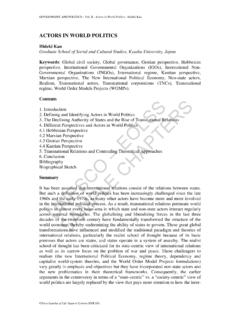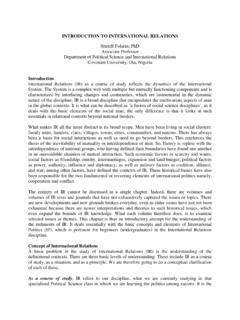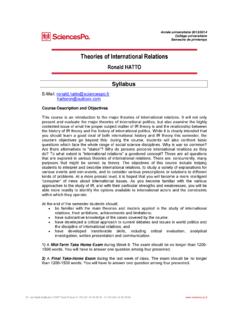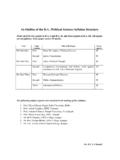Transcription of International relations: One world, many theories
1 Monday, July 24, 2000 DocumentPage: 1 relations : one world , many theories Foreign Policy; Washington; Spring 1998; Stephen M Walt; Issue: 110 Start Page: 29-35+ISSN: 00157228 Subject Terms: International relationsTheoryAbstract:The study of International affairs is best understood as a continuing competition between the realist, liberal, and radical traditions. Waltexplains each of these paradigms as well as some constructivist Text:Copyright Carnegie Endowment for International Peace Spring 1998 Why should policymakers and practitioners care about the scholarly study of International affairs? Those who conduct foreign policy often dismissacademic theorists (frequently, one must admit, with good reason), but there is an inescapable link between the abstract world of theory and the realworld of policy. We need theories to make sense of the blizzard of information that bombards us daily.
2 Even policymakers who are contemptuous of"theory" must rely on their own (often unstated) ideas about how the world works in order to decide what to do. It is hard to make good policy ifone's basic organizing principles are flawed, just as it is hard to construct good theories without knowing a lot about the real world . Everyone usestheories-whether he or she knows it or not-and disagreements about policy usually rest on more fundamental disagreements about the basic forcesthat shape International outcomes. Take, for example, the current debate on how to respond to China. From one perspective, China's ascent is the latest example of the tendency forrising powers to alter the global balance of power in potentially dangerous ways, especially as their growing influence makes them more another perspective, the key to China's future conduct is whether its behavior will be modified by its integration into world markets and by the(inevitable?)
3 Spread of democratic principles. From yet another viewpoint, relations between China and the rest of the world will be shaped by issuesof culture and identity: Will China see itself (and be seen by others) as a normal member of the world community or a singular society that deservesspecial treatment? In the same way, the debate over NATO expansion looks different depending on which theory one employs. From a "realist" perspective, NATO expansion is an effort to extend Western influence-well beyond the traditional sphere of vital interests-during a period of Russian weakness andis likely to provoke a harsh response from Moscow From a liberal perspective, however, expansion will reinforce the nascent democracies of CentralEurope and extend NATO'S conflictmanagement mechanisms to a potentially turbulent region. A third view might stress the value of incorporatingthe Czech Republic, Hungary, and Poland within the Western security community, whose members share a common identity that has made warlargely unthinkable.
4 No single approach can capture all the complexity of contemporary world politics. Therefore, we are better off with a diverse array of competingideas rather than a single theoretical orthodoxy. Competition between theories helps reveal their strengths and weaknesses and spurs subsequentrefinements, while revealing flaws in conventional wisdom. Although we should take care to emphasize inventiveness over invective, we shouldwelcome and encourage the heterogeneity of contemporary scholarship. WHERE ARE WE COMING FROM? The study of International affairs is best understood as a protracted competition between the realist, liberal, and radical traditions. Realismemphasizes the enduring propensity for conflict between states; liberalism identifies several ways to mitigate these conflictive tendencies; and theradical tradition describes how the entire system of state relations might be transformed.
5 The boundaries between these traditions are somewhatfuzzy and a number of important works do not fit neatly into any of them, but debates within and among them have largely defined the discipline. Realism Realism was the dominant theoretical tradition throughout the Cold War. It depicts International affairs as a struggle for power among selfinterestedstates and is generally pessimistic about the prospects for eliminating conflict and war. Realism dominated in the Cold War years because it providedsimple but powerful explanations for war, alliances, imperialism, obstacles to cooperation, and other International phenomena, and because itsemphasis on competition was consistent with the central features of the American-Soviet rivalry. Realism is not a single theory, of course, and realist thought evolved considerably throughout the Cold War. "Classical" realists such as HansMorgenthau and Reinhold Niebuhr believed that states, like human beings, had an innate desire to dominate others, which led them to fight also stressed the virtues of the classical, multipolar, balance-of-power system and saw the bipolar rivalry between the United States andthe Soviet Union as especially dangerous.
6 By contrast, the "neorealist" theory advanced by Kenneth Waltz ignored human nature and focused on the effects of the International system. ForWaltz, the International system consisted of a number of great powers, each seeking to survive. Because the system is anarchic ( , there is no centralauthority to protect states from one another), each state has to survive on its own. Waltz argued that this condition would lead weaker states tobalance against, rather than bandwagon with, more powerful rivals. And contrary to Morgenthau, he claimed that bipolarity was more stable thanmultipolarity. An important refinement to realism was the addition of offensedefense theory, as laid out by Robert Jervis, George Quester, and Stephen Van , July 24, 2000 DocumentPage: 2 scholars argued that war was more likely when states could conquer each other easily. When defense was easier than offense, however, securitywas more plentiful, incentives to expand declined, and cooperation could blossom.
7 And if defense had the advantage, and states could distinguishbetween offensive and defensive weapons, then states could acquire the means to defend themselves without threatening others, thereby dampeningthe effects of anarchy. For these "defensive" realists, states merely sought to survive and great powers could guarantee their security by formingbalancing alliances and choosing defensive military postures (such as retaliatory nuclear forces). Not surprisingly, Waltz and most other neorealistsbelieved that the United States was extremely secure for most of the Cold War. Their principle fear was that it might squander its favorable positionby adopting an overly aggressive foreign policy. Thus, by the end of the Cold War, realism had moved away from Morgenthau's dark brooding abouthuman nature and taken on a slightly more optimistic tone. Liberalism The principal challenge to realism came from a broad family of liberal theories .
8 One strand of liberal thought argued that economic interdependencewould discourage states from using force against each other because warfare would threaten each side's prosperity. A second strand, often associatedwith President Woodrow Wilson, saw the spread of democracy as the key to world peace, based on the claim that democratic states were inherentlymore peaceful than authoritarian states. A third, more recent theory argued that International institutions such as the International Energy Agency andthe International Monetary Fund could help overcome selfish state behavior, mainly by encouraging states to forego immediate gains for the greaterbenefits of enduring cooperation. Although some liberals flirted with the idea that new transnational actors, especially the multinational corporation, were gradually encroaching on thepower of states, liberalism generally saw states as the central players in International affairs.
9 All liberal theories implied that cooperation was morepervasive than even the defensive version of realism allowed, but each view offered a different recipe for promoting it. Radical Approaches Until the 1980s, marxism was the main alternative to the mainstream realist and liberal traditions. Where realism and liberalism took the state systemfor granted, marxism offered both a different explanation for International conflict and a blueprint for fundamentally transforming the existinginternational order. Orthodox marxist theory saw capitalism as the central cause of International conflict. Capitalist states battled each other as a consequence of theirincessant struggle for profits and battled socialist states because they saw in them the seeds of their own destruction. Neomarxist "dependency"theory, by contrast, focused on relations between advanced capitalist powers and less developed states and argued that the former-aided by an unholyalliance with the ruling classes of the developing world -had grown rich by exploiting the latter.
10 The solution was to overthrow these parasitic elitesand install a revolutionary government committed to autonomous development. Both of these theories were largely discredited before the Cold War even ended. The extensive history of economic and military cooperation amongthe advanced industrial powers showed that capitalism did not inevitably lead to conflict. The bitter schisms that divided the communist worldshowed that socialism did not always promote harmony. Dependency theory suffered similar empirical setbacks as it became increasingly clear that,first, active participation in the world economy was a better route to prosperity than autonomous socialist development; and, second, manydeveloping countries proved themselves quite capable of bargaining successfully with multinational corporations and other capitalist institutions. As marxism succumbed to its various failings, its mantle was assumed by a group of theorists who borrowed heavily from the wave of postmodernwritings in literary criticism and social theory.

















